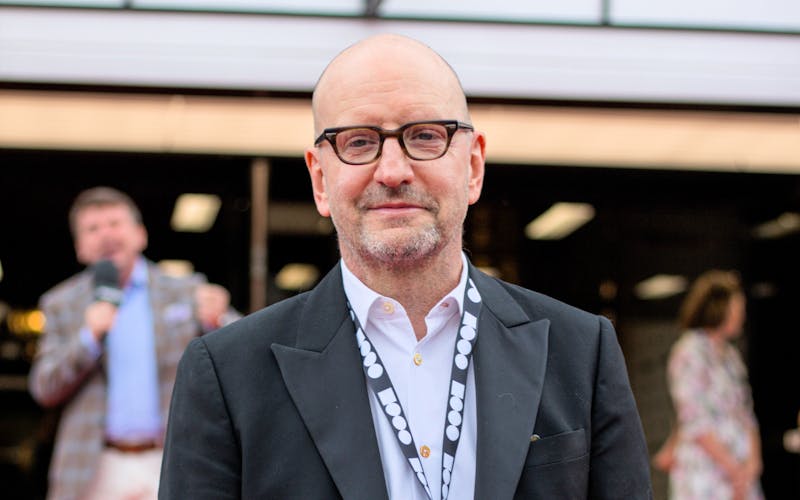Returning to a place that holds a lot of meaning is one of the strongest triggers of nostalgia. As college students, we tend to look towards familiar places from our childhood to feel comfort. After a stressful semester and some time apart from our lives at home, our neighborhood’s flower gardens, our favorite restaurants, or the parks we used to play in after school bring us warmth and solace. With summer quickly approaching, Penn students get to return to these places; we leave campus to recharge and rest before a busy new school year. We go to these familiar places to relive memories, to create new ones, to feel at home. For Jason Hochburg (Fred Hechinger), this place is Camp Pineway.
Hell of a Summer is the directorial debut of both Finn Wolfhard and Billy Bryk. Set in the 1980s, the film is about a group of counselors who return to camp with different hopes for their summer: Jason is hoping to connect with his younger coworkers; Chris (Finn Wolfhard) and Bobby (Billy Bryk) are wishing to find romance; and Claire (Abby Quinn) is looking to clear her head and heal from a breakup. Their weekend starts off perfectly—easy travel, heartfelt reunions, and a warm campfire. However, the group soon discovers that there is a slasher on the loose around the campground.
From the first frightening and tense scene with John and Kathy’s tragic deaths to the second sweet and tender scene with Jason and his mother in the car, Hell of a Summer quickly establishes itself as a movie that combines the horror and comedy genres. Not only that, but each of the genres helps one another throughout the storytelling process. According to Bryk, including elements from each genre “felt like a way for us to push the comedy further and try to make a movie that wasn’t like a horror movie and then a comedy … was sort of having one informing the other.”
Hell of a Summer executes horror comedy perfectly. The use of editing contrasted with the genres more evident, while also forging connections between the two. Anticipation builds as spooky music begins to hum and the camera focuses on an empty room. Suddenly, the shot cuts to a new location, where comical dialogue overshadows the fear of a jumpscare. The viewers can tell that there will be scary elements to the movie, but they're unable to identify the specific point within the plot line that they will appear in. This creates tension within audience members because they are constantly put in a position where they need to be on their toes throughout the film’s duration.
Comedic relief is an element that is not typically associated with slasher and horror movies. Similarly, when lighthearted humor is suddenly interrupted by jumpscares and terrifying music, people are shocked and startled. The combination of these two polar opposite genres betray expectations and causes an unrelentless fear to a level that would not occur in a comedy or horror movie alone.
Wolfhard and Bryk both started their careers as actors, and they explain that they first entered the industry because of their deep love for filmmaking and interest in understanding the filmmaking process further. Both of the directors were child actors, with Wolfhard taking on roles in Stranger Things and It, and Bryk taking on roles in Saturday Night and Friendship.
"When it came to the transition from acting into directing, the easy part was being able to understand actors and being able to communicate with actors in a way that I think made them feel seen and heard and comfortable on set," Wolfhard says. The two indicate that their prior acting experience helped them when writing the script and understanding their characters because they could more easily put themselves in the shoes of each of the characters to analyze their character development as the film progressed.
Their collaboration process started somewhat organically as they discovered that they love a lot of the same movies and had already written comedy slashers independently from one another. Once they started to work together, they discovered that they shared—as Wolfhard says—“the same mind in a lot of ways.” They consider the movie a symbol of their friendship, something that grew and developed alongside their partnership. “We are able to look back on this movie and think, this is an artifact of who we were at this time and what our relationship was and continues to be,” Wolfhard says. They first started writing Hell of a Summer at the beginning of their friendship and Bryk acknowledges that the partnership influenced their creative process: "Our sensibilities are very similar, but I don’t think this is the movie that either of us would have made on our own.”
Wolfhard and Bryk agree that the film also serves as a coming–of–age story. The duo have a lot of appreciation for both sides of the film production spectrum, from blockbuster to more independent film approaches. This becomes incredibly evident when they share their favorite scenes with myself and other student journalists. Wolfhard’s favorite scene is the climactic fire fight scene. He says that it was the first time that he thought about the project as “a real movie” because it was a professional, pre–choreographed scene with stunt doubles and firefighters on standby. Bryk loves the heartwarming moment shared between Claire and Jason when they reunite in front of the cabins. According to Bryk, “It felt like the smallest the movie had ever been. And then, on the flip side of that, the fire sequence felt like the biggest the movie had ever been, and yet both of them were rewarding in different ways.”
The film’s sleepaway camp setting is intended to instantly make viewers feel nostalgic. Bryk makes note of this when he reminds us that camps are “a very timeless place … because it hasn’t changed all that much in the last 60 years.” The two explain that they chose the setting of a sleepaway camp because it not only serves as a way to accommodate a young ensemble but also as a way for their movie to reach through time and show that the lived experiences of each generation are more similar than they seem.
Despite the spooky twist, the film perfectly encompasses the universal experience of what it means to be a teenager and young adult, navigating through different points of their lives while also living alone. It is a film about the strengths of friendship and the experiences of growing up. Using a Gen Z directing voice and blending elements of horror and comedy, Hell of a Summer successfully forges connections between different generations by capturing the timeless world of summer camp adolescence.






